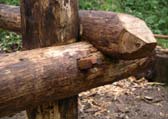The Project: St Fagans 06
In 2006 the St. Fagans National History Museum called in the Roundhouse Project to build a granary for their Celtic Village. In Archaeological terms, Iron Age granaries, are usually called 'four-posters'. This is because the only evidence they leave behind, 2000 years later, is four holes in the ground that used to hold upright posts. Therefore, as with any Archaeological re-construction, everything above ground is conjecture.
We opted for erecting a square building off these four posts. It would be far harder to erect a circular building from just these four posts. Fortunately, the Museum had a pile of Chestnut, that was ideal for the job. Ideally, four of these timbers would have been a bit longer, because our granary is a bit close to the ground. A granary looks like a house on stilts, for the taller the granary, the harder it is for hungry animals to steal the grain inside.
Four floor-beams were notched and pegged horizontally to our four upright posts. These hold the flooring which was made from cleft (split in two, down it's length) Chestnut. Four feet above these, we installed four wall-beams. Trapped between the two, were smaller upright posts, that Hazel would be weaved in-between, to form the wattle and daub walls. The tops of the four posts were cut at the appropriate angle to hold the four rafters. At the apex, these simply rested against each other. What holds the roof together, and consequently gives it strength, is the lashing of horizontal sticks, called purlins, to it. These are spaced twelve inches apart, and hold the thatch. The build, including thatching, took around five weeks. We left the fun part of covering the weaved walls with daub (cow manure, clay, and straw) to the children.
Home | News
| First Roundhouse | New
Roundhouse |Gallery Index
The Project | Resources
| Contact | Help
All content: © The Roundhouse Project 1997-2010





